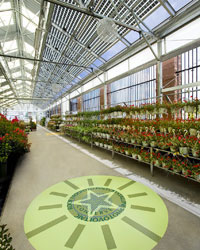Wal-Mart looks to eliminate non-renewable energy product offerings
Wal-Mart looks to eliminate non-renewable energy product offerings
mongabay.com
February 1, 2007
Wal-Mart Stores announced a new “Sustainability 360” environmental initiative on Thursday, encouraging employees, suppliers, communities and customers to reduce the “company’s direct environmental footprint.”
“Sustainability 360 takes in our entire company — our customer base, our supplier base, our associates, the products on our shelves, the communities we serve,” said Wal-Mart President and CEO Lee Scott. “And we believe every business can look at sustainability in this way. In fact, in light of current environmental trends, we believe they will and soon.”
Scott said Wal-Mart will start looking at ways to remove non-renewable energy from the products it sells.
 Polycrystalline photovoltaic laminates have been integrated into the Garden Center’s canopy in the experimental McKinney, Texas store to help reduce the store’s demand on the local electrical power grid. The Garden Center canopy is estimated to generate 14,585 kwh per year, which is enough electricity to power 486 single-family homes for one day and reduces greenhouse emissions by an estimated 22,100 pounds per year. Text and photo courtesy of WalMart Stores. |
“Perhaps the most far-reaching opportunity we have with our suppliers is a simple idea with potentially profound consequences,” said Scott. “Just think about this: What if we worked with our suppliers to take non-renewable energy off our shelves and out of the lives of our customers? We could create metrics and share best practices so our suppliers could make products that rely less and less on carbon-based energy.”
Scott says the company will work with suppliers to reducing packaging on products and aim to sell more energy efficient light bulbs than standard bulbs by 2008.
“We all have an opportunity to be more sustainable,” Scott said. “But even more, we have a responsibility. We need to be sustainable companies and countries made up of people who live sustainable lives. If we do that, if we do it throughout the coming decades, I believe we will make sustainability
sustainable. And this generation will leave a healthier humanity and a healthier planet to future generations.”
Related article
A Green Wal-Mart? Wal-Mart embraces environmental sustainability. While Wal-Mart is a favorite target for a broad spectrum of activist groups, the world’s largest retailer has taken a number of steps in recent months to improve the environmental sustainability of its operations. In October 2005, CEO Lee Scott presented an environmental plan to boost energy efficiency, increase organic food sales, and reduce waste and greenhouse gases emissions. Scott told reporters that the world’s largest retailer had to be a “good steward for the environment” and believed that adopting greener practices would also be good for business by cutting costs. As part of the plan, Wal-Mart will aim to cut greenhouse gas emissions by 20 percent by 2012—the Kyoto Protocol called for a 7 percent cut by the United States by that date, while targeting 100% renewable energy and zero waste. The company also announced commitments to social responsibility including increasing the number of women and minority managers.
This article is based on a news release from Wal-Mart.